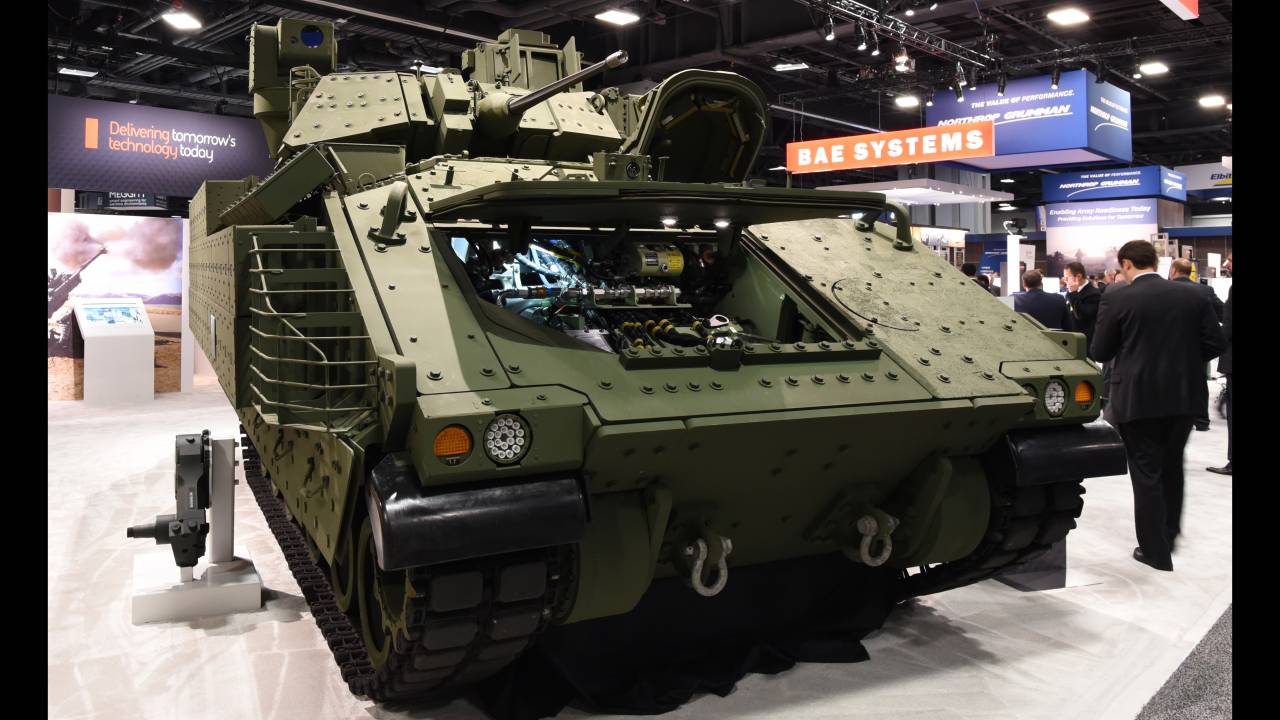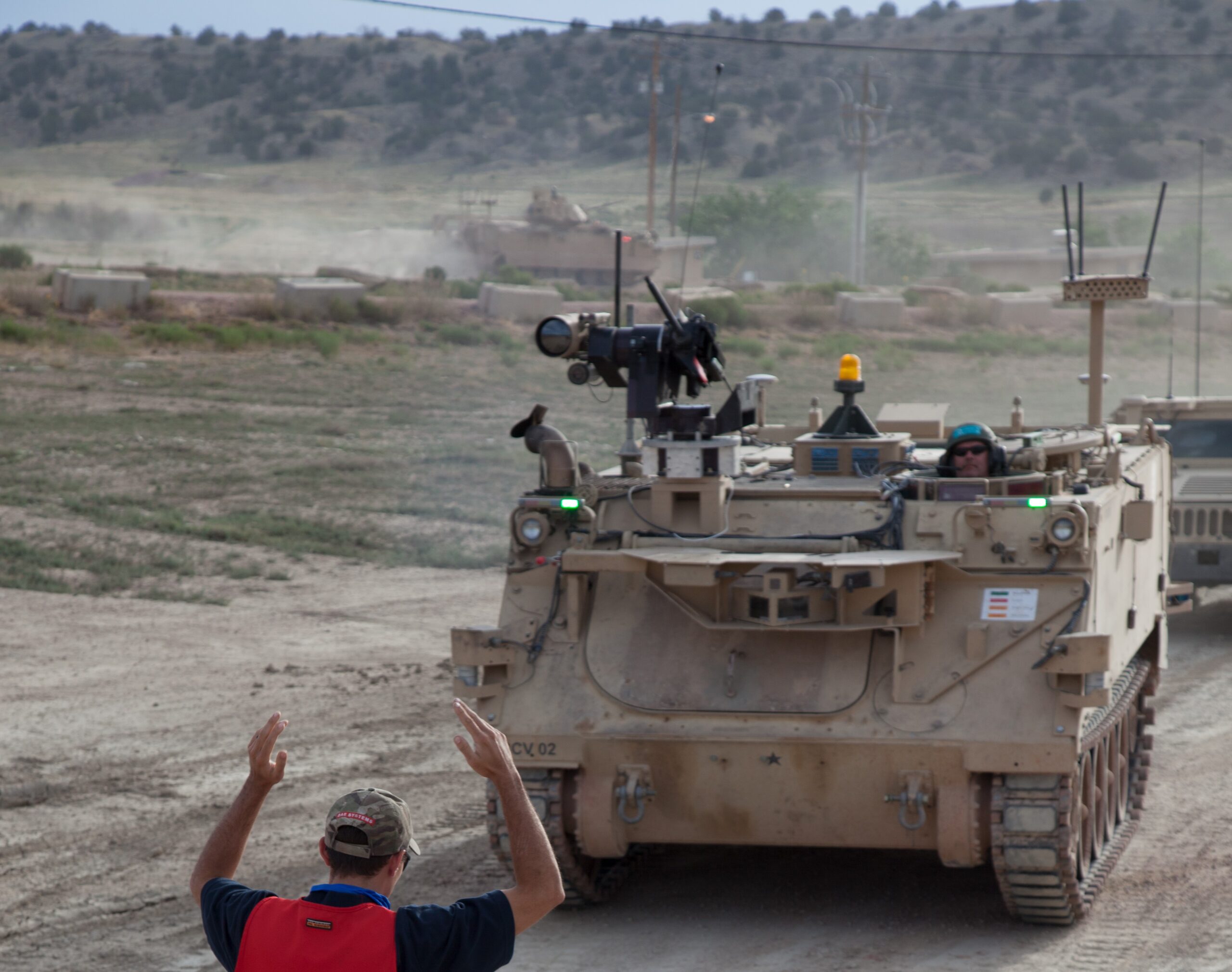Ampv Army Vehicle - A soldier from the 4th Squadron (Dark Horse), 9th Cavalry Regiment, 2nd Armored Brigade Combat Team, 1st Cavalry Division, completes field testing of a multi-role armored vehicle at Fort Hood, Texas, circa 2018.
The Armored Multi-Purpose Vehicle (AMPV) is a program of the US military. to replace the M113 armored personnel carrier and family of vehicles.
Ampv Army Vehicle

The U.S. military selected BAE Systems' proposal in 2014 for a turretless version of the Bradley Fighting Vehicle to replace more than 2,800 M113s in service.
Bradley Fighting Vehicle
, five AMPV variants are planned: M1283 General Purpose (522 planned), M1284 Medical Evacuation Vehicle (790 planned), M1285 Medical Vehicle (216 planned), M1286 Mission Command (993 planned), and M1287 (36 planned vehicle). .
According to the program, it is planned to deliver 2897 cars, the total price of which will reach 10.723 billion. USD or 3.7 million USD per vehicle.
The M113 has been in service since the early 1960s and, while capable of a variety of roles, has proven too vulnerable for combat. In the 1980s, the M2 Bradley replaced the M113 in the forward vehicle, relegating it to a rear area role. During the Iraq war, urban warfare tactics still prevailed against the M113, so it was almost completely replaced by MRAP vehicles. MRAPs are useful on Iraqi roads, but have lower payloads and poorer off-road handling. The AMPV seeks to find a vehicle that is more flexible and mobile against a variety of enemies, with off-road mobility comparable to the Bradley and M1 Abrams tanks.
Some reports suggest that the AMPV program is better than the Ground Combat Vehicle (GCV) program. Although the acquisition of the AMPV fleet will cost more than 5 billion. USD, the Government Accountability Office estimates that the GCV fleet will cost $37 billion. in 2013 in April The Congressional Budget Office said the AMPV would be a better buy because analysts made it clear the vehicle the GCV would replace could not be the first. The GCV will replace 61 M2 Bradley infantry fighting vehicles in each armored combat brigade, representing 18 percent of the 346 armored fighting vehicles in each armored brigade.
Ampv, M2a4 And Stryker A1. Build Or Upgrade?
In 2013 September. A report by the Congressional Research Service suggests that a GCV program may not be feasible given budget constraints, and that one possible discussion could focus on the Army's decision to replace GCVs with AMPVs as the first priority for ground combat vehicle procurement.
Army in 2015 the fiscal year budget proposal proposed to cancel the GCV program and transfer funds to AMPV as a service priority vehicle program.
To reduce development costs, the Army requested that the vehicle be of a commercial design that could be upgraded in stages. The vehicle will incorporate new technologies, including electronics, networking and communications equipment, as they become available. If AMPVs can carry newer communications satellites as they are developed, they can be paired with other ground vehicles that would normally require a complete subsystem overhaul for new equipment in a few years.

The operational maintenance cost requirement for the AMPV is up to $90 per mile compared to $58 per mile for the M113.
Armored Cars: Kmw Ampv
In 2013 March. The military has released a draft request for proposal for the AMPV. The RFP offered a $1.46 billion contract for the design and development phase. During the Engineering and Manufacturing Development (EMD) phase, 29 prototypes will be built over four years from 2014 to 2017 at a cost of 388 million. Low Level Initial Production (LRIP) from 2018 to 2020 was 1.08 billion $289 for series models. After 2020 the army plans to purchase another 2,618 vehicles in year t for a total of 2,907 AMPVs. The price of one vehicle does not exceed 1.8 million. USD, and the total cost of the tire fleet is 4.7 billion. As with the updated GCV program, one development contract will be awarded to one company.
In 2013 October month. the Army issued a new draft RFP that delayed the start of the program by a year and increased development costs by several hundred million dollars. The new document states that in 2014 In May, the Army plans to award a five-year EMD contract to a single contractor to build 29 vehicles for government testing, followed by a three-year LRIP contract beginning in 2020. The EMD phase has been extended from FY. In the 2015-2019 financial year and the cost of developing 29 prototypes increased to 458 million.
Spending over the three years of the LRIP was $244 million for 289 vehicles. USD in the first year, 479 million. USD in the second and 505 million USD in the third year, bringing the total to 1.2 billion. USD for low level production. AMPV will cost $1.68 billion to enter full production, up from $1.46 billion previously. The new project does not change the total number of vehicles desired and does not include the average unit cost of production. Congress approved $116 million for the program. USD in 2014 in the military budget for the fiscal year.
The AMPV had a relatively long production schedule for the non-development vehicle at 13 years: 3 years for low-level production and 10 years for full-level production. The production plan was based in part on budgetary constraints, but also on the possibility of speeding up production in case of war or other contingencies. 33 percent of the Armored Brigade Combat Team (ABCT) consists of the M113, which is not used in combat operations because it is less mobile and less protected than other combat vehicles in the ABCT. Full-scale production should produce fewer than 300 AMPV vehicles per year, but there is scope for rapid production increases if ABCT is required. It is irresponsible to routinely allow an industry to build as quickly as possible only to have it shut down later.
Hungary Receives Turkey Made Armored Vehicle Gidran
In 2013 in November, the Army issued a formal RFP for the EMD AMPV phase. Despite the sequester budget cuts, the program has maintained its earlier goal of 2,907 vehicles at a cost of $1.8 million each. USD produced over 13 years. in 2014 in May, one manufacturer will be awarded a 5-year EMD contract to produce 29 vehicles for testing, and in 2020 a 3-year LRIP contract will be concluded. Although in October In the draft RFP, the cost of the EMD phase has been increased to 458 million. , officially reduced the November RFP to $436 million.
The annual cost for the EMD stage was 70 million. USD in 2015, 174 million USD in 2016, 114 million USD in 2017, 64 million USD in 2018 and 14 million USD in 2019 FM. replace up to 78 vehicles during the EMD phase with AMPVs. 39 Bradley vehicles up to the current M2A3/M3A3 configuration and 39 M113 vehicles other than the M113 AMEV are available for sale by the government to contractors on credit.
In 2014 February. General Dynamics filed a protest with the Army Materiel Command, arguing that the AMPV requirements were written to support a chassis based on the BAE Systems Bradley Fighting Vehicle, making it difficult to compete with their Stryker design or other foreign designs. in the program. They point to the ability to use the Bradley as an optional exchange vehicle, which is difficult for competitors who don't offer chassis, the military doesn't provide Bradley component performance data outside of BAE that they can use to develop tracked proposals, and mobility requirements. This does not include wheeled vehicles, which require a vehicle that can go 100 percent where the M113 can go, including very soft ground.

BAE said that the military's changing mobility needs, from zero turning radius to a larger turning radius that can be accommodated on wheeled structures, does not define a Bradley-based vehicle as a pure Bradley solution; The survivability requirements of the AMPV were higher than the M2 with the Bradley Urban Survival Kit (BUSK) III. Navistar Defse also offers the MRAP MaxxPro for some AMPV roles. The idea is to replace the faster M113 with the more mine-resistant MaxxPro before the AMPV enters service in 2020.
Top 10 Army Modernization Efforts Of 2016
Army Materials Command was killed in a 2014 General Dynamics protest. in April Their response was that while BAE had the advantage as the maker of the Bradley and the M113, the government was under no obligation to neutralize them and it was not preferential treatment. Regarding OEVs, the Army Materials Command explained that they could not be specifically used for conversion, but could still be traded for overseas sales or written off, which would be less economical. Geral Dynamics could appeal to the Government Accountability Office with its protest or withdraw from the tender.
In 2014 in April Geral Dynamics issued a statement saying it would not file a complaint with the GAO, but would still face scrutiny in negotiations with Congress and the Defense Department. The company may feel it has a better chance of gaining support through Congress, which supports the strategy of buying Stryker and Bradley vehicles, and is less likely to act if the dispute goes to the GAO to avoid damaging the bottom line. protest. An AMPV proposal must be submitted
Us army mule vehicle, army surplus vehicle sales, army vehicle, army vehicle decals, ampv vehicle, army ampv, ex army vehicle, army surplus vehicle auction, army vehicle for sale, us army ampv, army surplus vehicle, army vehicle toy set
0 Comments